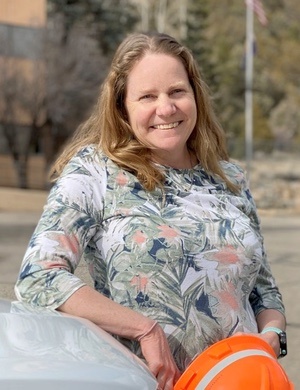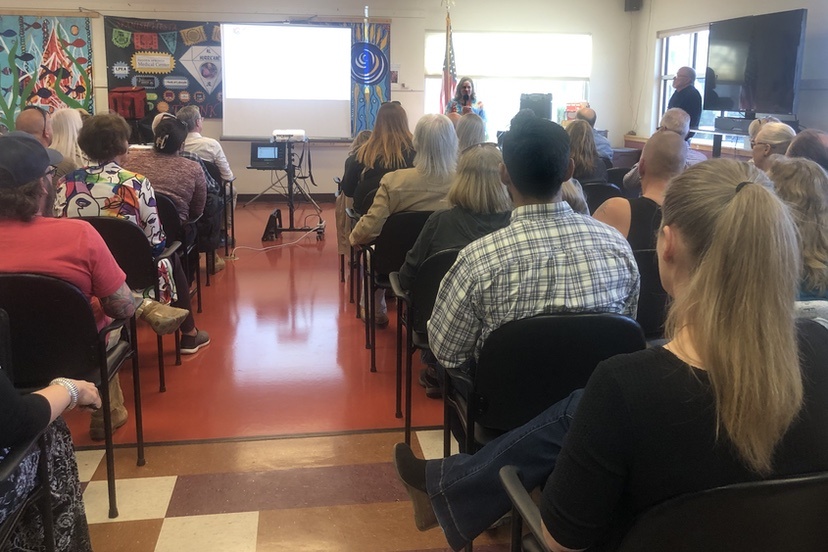One of the most well-attended political meetings in recent memory took place on April 4 in the Senior Center dining room at the Ross Aragon Community Center.
The intent of the meeting — hosted by the Town of Pagosa Springs and Colorado Department of Transportation (CDOT) — was to bring the community up-to-date on the planned Highway 160 reconstruction project which will be playing havoc with our downtown traffic patterns and parking options for the next two years, starting (theoretically) in June.
Or maybe, starting next year?
Many aspects of the planned project were still unclear at the presentation, which was handled mainly by Julie Constan, Regional Transportation Director for Region 5 in southwest and south-central Colorado. She leads a team of more than 300 employees who are responsible for planning, design, construction, operations and maintenance of Colorado highways in a 15-county area. When she was promoted to Regional Director in 2021, CDOT posted a webpage announcing her appointment, that reads, in part:
“Julie will be leading a strong and dedicated team with a lot of challenging and exciting work ahead,” said CDOT Executive Director, Shoshana Lew. “In her four years with CDOT, she has served as the region’s traffic and safety program engineer developing close working relationships with local agency partners to improve safety and multimodal options along the region’s state highway system.”
In her role as Region 5’s traffic and safety engineer, Constan led the effort to secure an Advanced Transportation and Congestion Management Technologies Deployment (ATCMD) grant to lay fiber optic cable over Wolf Creek Pass and continue to expand access of fiber to southwestern Colorado. That project will allow for the deployment of “intelligent transportation devices” to communicate with commercial trucks and reduce truck crashes on the west side of Wolf Creek Pass.
“I was raised in Pagosa Springs and joined CDOT Region 5 with a love for the mountains of southwest Colorado and the beautiful San Luis Valley,” said Constan. “I’m excited to continue to build upon the strong relationships I’ve established with community members and leaders in our region’s communities.”
Those “strong relationships” were not terribly evident in the Senior Center dining room on April 4.
The meeting was meant to be mainly ‘informational’… but it became intensely political when Director Constan finished explaining the current situation, and opened the floor to questions. And to complaints… and suggestions.
Ms. Constan began by noting that the project has a budget of about $19 million.
“That’s a good project. That’s a lot of money for Region 5. We’re the smallest region in the state, and we get the smallest amount of money. So we have to be very careful with our dollars.
“In 2021, our right-of-way team came over to Pagosa and met with a bunch of property owners that we needed to get easements from… so we were out in the community, trying to meet with business owners, trying to make sure they understood how it was going to impact them, how the project was coming through.
“Then in 2022 and 2023, [PSCDC Executive Director Emily Lashbrooke] invited me to come over and meet with the CDC. And then in 2024, when the ‘Cone Zone’ group formed, we’ve been to a couple of those meetings, too…
“We’ve been thinking about this project, definitely since 2017… and we’ve tried to use the avenues here, to let people know that we were coming.”

Ms. Constan explained that the project was currently out for bid, and that four major concrete contractors have been provided sets of plans and are looking them over. One of the contractors asked CDOT to extend the deadline by “a few weeks” and CDOT agreed to the extension.
“The bids will be opened a week from today, and if we get a bid that we can afford — because we do have a limit — as long as we get a bid, then the theory is, within 30 days of the bid opening, our contracts team up in Denver tries to make sure we have a contract executed and we’re ready to issue a notice to proceed.”
She made it clear that this timeline was somewhat theoretical. “In general, we aim for that 30-day window…”
Work might commence in mid-June… if all the pieces fall into place.
“I understand that puts us at the beginning of the summer tourist season, but mostly likely, they are not going to just come in and rip up half the highway, and disturb everything right away. It takes time, as the project starts moving, for those disturbances to start to happen…
“But yes, that’s when we will see things start moving here in town. In theory.”
If CDOT fails to get bids they can afford, the allocated funding will be preserved, and CDOT will go back out to bid again in the fall, “when contractors seem to be the hungriest.”
(We might be able to find out, today, the status of the bidding process?)
Typically in the past, CDOT has required the contractor to have a dedicated public information officer, charged with keeping the community and local governments informed during the project. Ms, Constan noted that, in this case, CDOT is going to maintain their own public information officer, who will work closely with the CDOT construction management consultant.
“We have over 500 plan sheets to tell the contractors what they have to do to build this project. There is a time limit. They have 382 ‘working days’ according to the contract. That is why it’s a two-season job, because they will not be working 382 consecutive days. But they do have 382 days to work through this project. There will most likely be a winter shutdown of this project…” She promised at least two traffic lanes will be open throughout the duration of the project — and hopefully, more than two lanes during a winter shutdown.
Theoretically.
Ms. Constan made it clear that the phasing of the project, and most operational decisions, will ultimately be decided by the contractor, not by CDOT.
Thus, she was unable to clearly state when any specific portion of the work will be done, and how it will be scheduled and managed.
This apparent abdication of control and authority over the project, beyond the specs included in the contact and in the 500 plan sheets, did not sit well with the packed audience…

